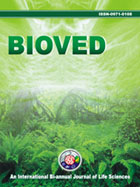Bioved Journal
Bioved : An International Bi-Annual Journal of Life Science
Aims and Scope
Bioved Bi-Annual journal published by Bioved Research Society, Allahabad, U.P., India located at Bioved Research Institute of Agriculture & Technology, 103/42 M. L. N. Road, Allahabad-211002, U.P. is a official publication of the society, The journal is committed to promote growth and development of the Plants and Animals . Scientists all over the world may publish their research contributions in basic and applied Algae, Fungi Microbiology, Plant Pathology, Cytology, Ecology, Genetics & Plant Breeding, Taxonomy, Embryology of Plant, Morphology & Anatomy of Plant, Economic Botany, Plant Physiology, Biotechnology, Biochemistry, Invertebrate and Vertebrate animal, Histology, Embryology, Anatomy, Physiology and genetics of animal, biochemistry cell biology, reproduction Environment science and all other related fields The Journal favors publication of full-length research/ review articles short communication/ Book review related to Life Sciences. where modern scientific technologies are used to explain molecular, cellular and physiological mechanisms. Articles should be written at a level accessible to readers who are non-specialists in the topic of the article themselves, but they are interested in the research. The Journal welcomes mini-reviews on topics of wide interest to investigators in the life sciences. We particularly encourage submission of brief, focused reviews containing high-quality artwork and require the use of mechanistic summary diagrams.
Manuscripts should present novel preclinical findings addressing questions of biological significance to human disease. Studies that fail to do so may be rejected without review. Quantitative conclusions must be based on truly quantitative methods. Bioved does not publish work on the actions of biological extracts of unknown chemical composition. Compounds studied must be of known chemical structure and concentration. The study must be reproducible; materials used must be available to other researchers so they can repeat the experiment. Four common reasons for rejection include: out of scope (the manuscript does not conform to the goal of identification of mechanisms related to plant and animal science; too preliminary (manuscript is based on a limited amount of experimental data diminishing significance); lack of novelty (manuscript is well done but does not address a significant question); unidentified structure (actions of biological extracts of unknown chemical composition).
The journal started in 1990 and so far 24 Volumes have been published covering about 2000 research papers.
How to Subscribe

